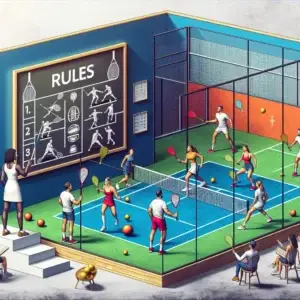Overview of Padel Rules
Understanding padel rules is essential for all players, whether you are just starting or looking to refine your skills. Learning how to play padel effectively involves mastering techniques such as positioning on the side of the court, using a padel racket efficiently, and understanding proper scoring methods.
Padel is a dynamic and fast-paced sport that combines elements of tennis and squash. It is played in a semi-enclosed court with glass walls, requiring skill, teamwork, and strategy. The game originated in Mexico in the 1960s and has since gained immense popularity worldwide. Understanding the rules of padel is essential for players at all levels, from beginners to professionals.
As experienced padel player and researcher, I have spent years analyzing and playing this sport to deepen my understanding of the game. This guide is based on my firsthand knowledge and extensive study of official FIP regulations.
Why Padel is Gaining Popularity
Padel is one of the fastest-growing racket sports worldwide, and its popularity continues to rise for several reasons:
- Easy to Learn, Hard to Master – The basic rules and techniques are simple enough for beginners to pick up quickly, yet the strategic depth keeps advanced players engaged.
- Social & Fun – Padel is typically played in doubles, making it a great social activity for players of all skill levels.
- Longer Rallies – Compared to tennis, padel rallies tend to last longer due to the enclosed court and slower ball speed, making the game more exciting and engaging.
- Less Physical Strain – The underarm serve and smaller court size make padel easier on the body, reducing the risk of injuries.
- Strategic Wall Play – Unlike other racket sports, players can use the walls to create unique shot angles and unexpected returns, adding an extra tactical layer to the game.

Basic Padel Rules and Gameplay Explanation
A padel match begins with a serve, followed by a rally where players hit the ball back and forth, attempting to score points. Here’s how a typical point unfolds:
- The Serve: The player serving must serve underarm from behind the service line, bouncing the ball in their service box diagonally across the net.
- The Return: The receiving player must let the ball bounce once before returning it.
- The Rally: Players continue hitting the ball, using the walls strategically to keep the rally alive. The ball must bounce before hitting the wall on their own side.
- Winning a Point: A team wins the point when the opponent fails to return the ball within the rules (e.g., the ball bounces twice, hits the fence before bouncing, or is hit out of bounds).
A game is won when a player or team reaches four points (15, 30, 40, game). A set is won by the first team to win six games with a two-game lead, and a match is played as a best of 3 sets.
Key Differences Between Padel and Other Racket Sports
Walls as a Part of Play
Unlike tennis, where hitting the wall results in a fault, padel wall rules allow players to use the walls strategically. Players use walls to defend against aggressive shots, set up lobs, and create sharp angles to outplay their opponents.
Wall Play Strategies:
- Offensive Play: Hit the ball off the back wall to prepare for a volley at the net.
- Defensive Play: Use the side of the net or back wall to return a deep, fast ball when under pressure.
- Angles & Tactics: Hitting low off the court before hitting the wall forces opponents into difficult positions.
Court Size and Structure
- Court Dimensions: 10m x 20m, enclosed by glass walls and metal fencing.
- Court Division: The court is divided into two halves by a net, with service boxes marked for serving.
- 1v1 Padel Court: Singles matches are played on a narrower version of the standard padel court, sometimes marked with temporary lines.
Serving Rules in Padel
- The serve must be executed as an underarm serve, bouncing the ball behind the service line before hitting it.
- The ball must bounce in the opponent’s service box diagonally.
- If the first serve is a fault, a second serve is allowed.
- The serving team rotates servers every game.
- The receiving players must stand behind the service line until the ball is hit.
- If the ball touches the net and lands in the correct service box, it is a valid serve and is replayed.
Scoring System in Padel
Padel scoring follows the same structure as tennis:
- Points are counted as: 15, 30, 40, game.
- Deuce (40-40): If both teams reach 40-40, the next point wins the game under the Golden Point rule (used in most professional matches).
- Winning a Set: To win one set, a team must win six games with a two-game lead.
- Winning a Match: Matches are played as a best of 3 sets.
The Golden Point rule replaces the traditional advantage system in some tournaments, where the next point after deuce determines the winner of the game.
Faults & Violations in Padel
Common Serve Faults:
- The serve must bounce in the correct service box diagonally.
- Foot Faults: Server steps over the service line before hitting the ball.
- Second Serve Fault: If the second serve is also a fault, the receiving team wins the point.
Common Rally Faults:
- The ball must bounce before hitting the wall on the serving side.
- The ball bounces twice before being returned.
- The ball is hit directly into the fence without bouncing on the court.
- Interference: A player obstructs their opponent intentionally, affecting the point.
When Do Players Change Sides?
- Players change sides after every odd-numbered game in a set.
- In a tiebreak, sides are switched after every six points.

Common FAQs & Misconceptions
Can the Ball Go Outside the Court?
Yes, if the ball bounces inside the opponent’s court first, a player can go outside the enclosure to return it (if the court allows for this).
What Happens if the Ball Hits the Fence?
- If the ball must bounce before hitting the fence, it is still in play.
- If the ball hits the fence before bouncing, it is out.
Padel vs Tennis: What’s the Difference?
- Padel courts are smaller, enclosed, and played mostly in doubles.
- Padel vs 1v1: While doubles is the standard, 1v1 matches are played on a narrower court with adjusted boundaries.
What Are the Advantages of Padel?
- Padel is easier to learn than tennis and requires less power but more strategy.
- The scoring system is similar to tennis, making it easy to adapt.
- Matches are fast-paced and commonly played as sets with long rallies.
Conclusion
Mastering padel rules is key to improving your game, whether you’re a beginner or an advanced player. Learning the nuances of scoring, serving, and wall play will give you a competitive edge.
For more details on official padel rules, including scoring, visit the FIP Website or Ruley.AI.
